The global transition away from fossil fuels in favor of low carbon energy sources is accelerating. In 2022, a little more than $1 trillion was invested in new technologies such as renewable energy, energy storage, carbon capture and storage, electric vehicles, and more.
Not only is this a new annual record amount, but—for the first time ever—it matches the amount invested in fossil fuels, according to Bloomberg New Energy Finance (NEF).
However, at the same time that copper demand is growing due to the energy transition, the global supply pipeline is running thin, due to shrinking exploration budgets and a dramatic slowdown in the number of new deposits discovered, as well as the quality of those deposits.
That’s why—after a long period of relatively small deals—large mining mergers and acquisitions deals focused on copper are back in a big way.
Here’s the ones to look at…

Mining M&A
The latest salvo came from mining giant Glencore PLC (GLNCY), which announced on April 4 an unsolicited $23 billion offer to buy Canada’s Teck Resources (TECK). If the offer is accepted, it would create the world’s third-largest copper miner, producing 1.4 million tons of the metal a year.
On April 11, Glencore sweetened its offer. Under the revised proposal, it has offered to pay a cash element that could amount to $8.2 billion to buy Teck shareholders out of their stake in a coal-focused spin-off, while also granting them a 24% stake in a separate industrial metals business that would be created off the back of the deal.
“Glencore acknowledges that certain Teck investors may prefer a full coal exit and others may not desire thermal coal exposure,” the company said in a statement. As such, the revised offer allows investors to choose cash instead of shares or a combination of both in the coal spin-off. However, the valuation of the total offer remains the same as the original bid, at about $23 billion.
Glencore is hardly alone in its interest copper. The M&A spree extends to the $6.5 billion bid for Australia’s Oz Minerals by BHP Group Ltd (BHP), the recent takeover of Turquoise Hill by Rio Tinto PLC (RIO), and the Newmont Mining (NEM) unsolicited $17 billion offer for Australia’s Newcrest Mining (NCMGY), which was raised to $19.5 billion on April 11.
Under the terms of the revised Newmont offer, Newcrest shareholders would also get some cash. This would be a special dividend of $1.10 a share, worth almost $1 billion in total. Newcrest investors would also get a bigger share of the combined company. Newmont is offering 0.4 of its own shares for each one they hold, up from 0.38 at the previous attempt.
All these deals have something in common: copper. The world’s need for copper is driving this surge of interest from miners, all of whom anticipate a shortage later this decade, and have plenty of cash to put to work after years of high profits.
As we seek to electrify everything, from power generation to transportation to heating (heat pumps), copper is the one material that’s used everywhere in the energy transition. Copper’s essential role in electrical wiring, grid infrastructure, wind turbines, and electric vehicles makes it indispensable for the energy transition.
Demand for copper could rise to 40 million tons a year by 2030, up from 25 million tons a year in 2021, according to estimates from S&P Global. Given that it takes up to a decade to open a producing copper mine, the coming shortfall is inevitable.
However, much of the world’s most accessible, high-grade copper deposits have already been mined. The stark reality was laid out by S&P Global, which stated that most of the copper that’s being produced currently comes from assets that were discovered in the 1990s!
That leaves relatively few high-quality copper resources still available, with the easiest way to find such resources on the stock market and not through exploration. That has led to fierce competition among the major miners for these dwindling resources.
BHP Group
Among the major miners, my top choice remains BHP Billiton. The company mines copper, silver, zinc, molybdenum, uranium, gold, iron ore, as well as metallurgical and thermal coal. It also is involved in mining, smelting, and refining of nickel and potash production. Most of its revenues come from assets in the relative safe havens of Australia, North America, and Europe.
To say the least, the company—the world’s biggest mining company, as measured by market capitalization—is doing quite well.
Adjusted free cash flow in fiscal year 2022 totaled $24.3 billion (a new record year) and up from the previous record of $19.4 billion, set in the 2021 fiscal year. That has allowed BHP to pay down its debt—net debt of $333 million, as of June 30, 2022, is down from more than $20 billion in the 2016 fiscal year.
This puts BHP in a position to weather economic cycles—especially since its generally low-cost, high-quality assets mean the company is one of the few miners that can remain profitable through the commodity cycle.
Despite weak output from its flagship Escondida mine in Chile, BHP management maintained copper guidance, given the strong performance of the company’s other copper mines. BHP’s copper division accounts for about 20% of the miner’s forecast earnings.
The company is paying a fair price for Oz Minerals. And with net debt of about $7 billion—around 0.2 times its EBITDA (as of the end of December 2022), BHP can easily afford the $6.6 billion price tag for Oz Minerals.
BHP’s offer is a bet on copper as well as nickel, with continued confidence in Australia’s relatively stable geopolitics. The deal will also offer BHP a pipeline of growth opportunities.
Oz Minerals’ Prominent Hill and Carrapateena mines are both close to BHP’s Olympic Dam mine (the world’s fourth-largest copper deposit and the largest known single deposit of uranium) and Oak Dam prospect, opening up the potential for synergies with infrastructure. And Oz’s West Musgrave nickel and copper project in Western Australia is under construction. It will likely supply nickel to BHP’s Nickel West operations once fully ramped up later this decade.
BHP shares have rallied by 17% over the past six months. I expect more to come. While its dividend will not be as massive as it had been over the last year or two, BHP will still treat shareholders generously. The current dividend yield of 8.8% is nothing to sneeze at.
The stock can be bought anywhere in the low $60s per share.





